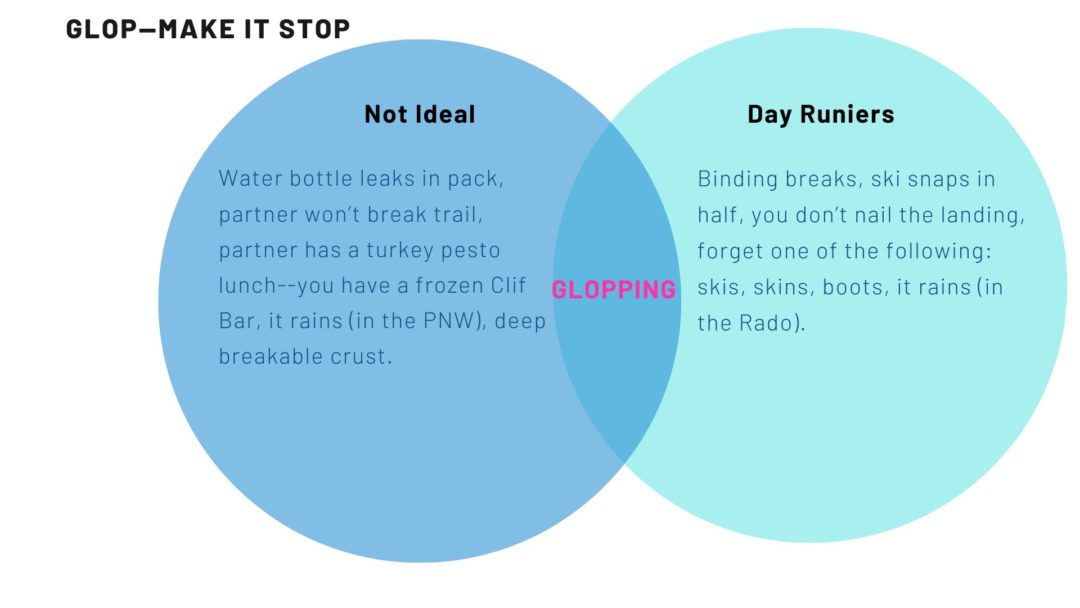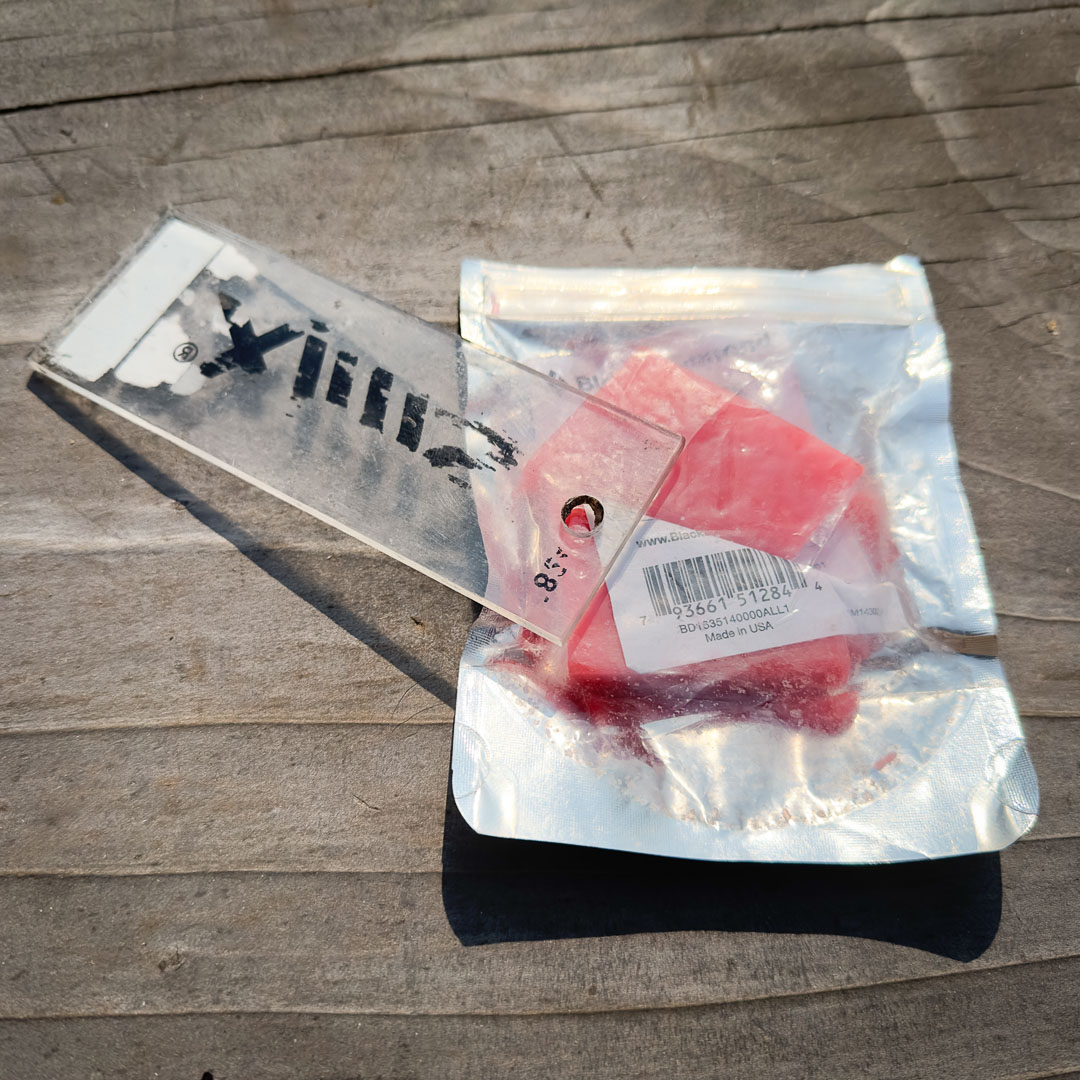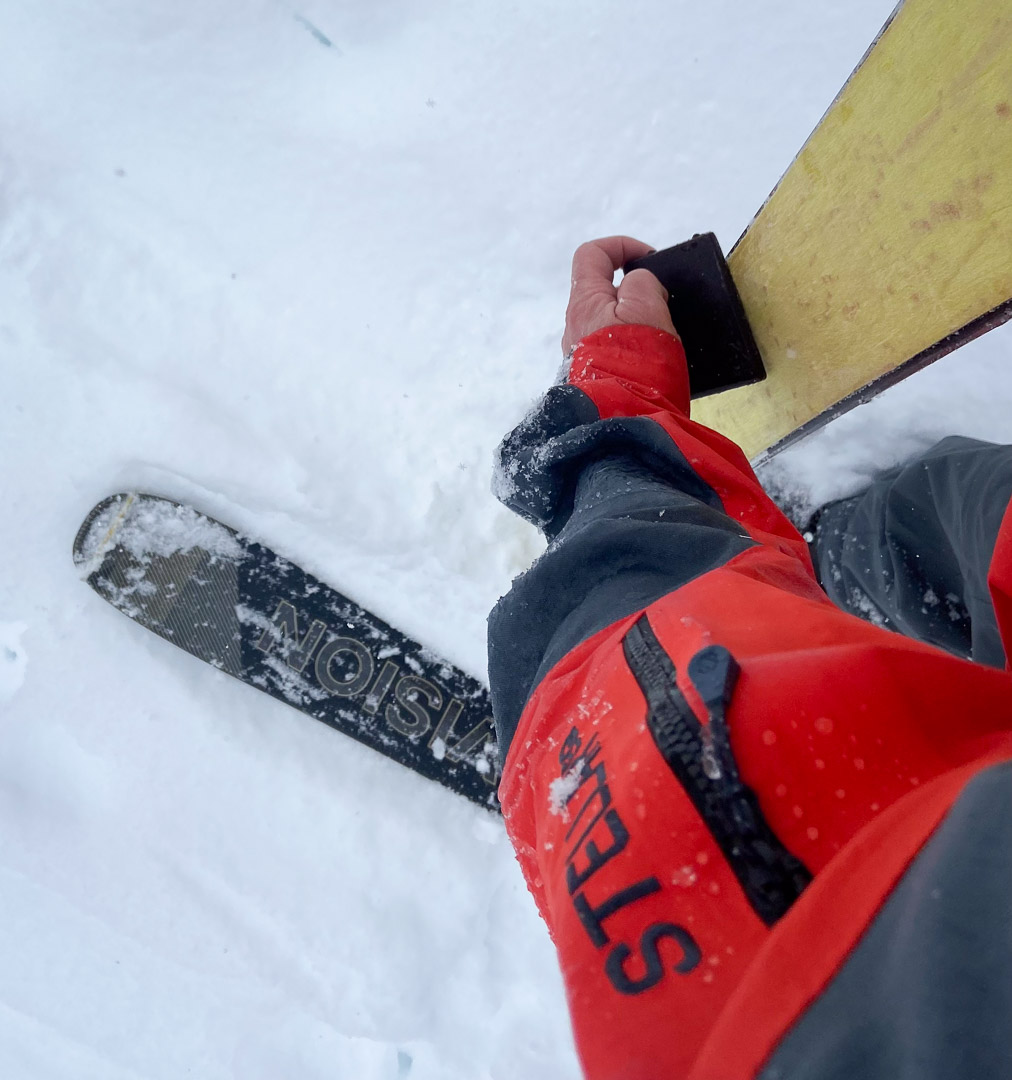There’s a saying to help remedy the buzzkill known as glop: An ounce of prevention is worth a pound of cure. In other words, prevent glop by using skin wax and have a scraper handy.
If you were creating a Venn diagram of the small and marginally costly mistakes one can make in the backcountry, you’re likely to find the word “glop” somewhere near the nexus of the diagram. Glop is the term for snow/ice buildup, usually right underfoot, on your skin, (or your ski base).
Glop will weigh you down. Glop will slow you down. And often, glop will make you turn around.
There’s a saying to help us remedy this potential buzzkill: An ounce of prevention is worth a pound of cure. Certainly, most cultures have their version, and it’s a spot-on proverb for skinning awareness; glop can weigh several pounds, and some say its cosmic weight is exponentially heavier if it enters the buzzkill realm. Nobody wants a trip ruined by glop.

Glopping—in between not ideal and a day ruiner. It’s possible to keep glopping more towards unideal and not the day ruining fiasco side of the Venn diagram.
Glop Awareness
Glop happens. And it often builds up when skinning from sunny zones into shaded zones, particularly when there’s fresh snow. If air and snow temperatures are several degrees below freezing, there’s likely not much to worry about, as your skin remains cold and devoid of free water. But as temps warm towards the freezing point or above, skins tend to wet out (absorb moisture) in high wear zones—like under your foot. As you skin from sun to shade, where the temps are likely at or below freezing, powdery snow will begin to stick and build up on your skin. You might notice increased friction when sliding the skin forward as the glop builds. If it all hits the fan, things can literally snowball: you’ll end up with several inches of snow/ice underfoot. The worst case is you’ll feel like you’re walking on mini-stilts.
That worst case, walking, is the antithesis of what you want to be doing: sliding on snow. In either case, some friction or mini-stilts, stop and scrape the buildup off with a scraper, apply skin wax, and proceed with the day.
Two items to remain glop aware and glop prepared: skin wax and a plastic scraper.

Spring essentials: a plastic scraper and skin wax. However, the reality is, these are probably essentials no matter the season. Might as well keep them in your pack.
Glop Preparedness—Stop the Glop
Glop happens. It often builds up when skinning from sunny zones into shaded zones, particularly when there’s fresh snow. If air and snow temperatures are several degrees below freezing, there’s likely not much to worry about, as your skin remains cold and devoid of free water. But as temps warm towards the freezing point or above, skins tend to wet out (absorb moisture) in high wear zones—like under your foot. As you skin from sun to shade, where the temps are likely at or below freezing, powdery snow will begin to stick and build up on your skin. You might notice increased friction when sliding the skin forward as the glop builds. If it all hits the fan, things can literally snowball: you’ll end up with several inches of snow/ice underfoot. The worst case is you’ll feel like you’re walking on mini-stilts.
That worst case, walking, is the antithesis of what you want to be doing: sliding on snow. In either case—some friction or mini-stilts—stop and scrape the buildup off with a scraper, apply skin wax, and proceed with the day.
Two items to remain glop aware and glop prepared: skin wax and a plastic scraper.
The ounce of prevention in the case of stopping glop is applying skin wax before you encounter potential glopping situations. In spring, apply skin wax before you depart and reapply after several hours of skinning. Remember, an ounce is much lighter than a pound.
To apply skin wax, rub the wax generously into the skin in a tip-to-tail direction. After the tip-to-tail treatment, get a bit more aggressive and apply the wax with a back-and-forth motion to adequately coat the individual skin hairs. Focus attention during the application process to the skin zone under foot, as this is where the glopping often starts and propagates.
If you space on applying skin wax, or the karmic forces don’t align, and you glop, take a deep breath and grab the wax scraper you certainly packed. A plastic wax scraper will cost a few dollars and weigh a few ounces. If you have a kind partner, kick the affected ski/skin vertically, and have said partner scrape the glop/snow/ice free of the skin, and apply skin wax. If your partner isn’t into it, no problem. Remove the ski, scrape the skin.
A key aspect here is to try and remove any free water from the skin—in other words, optimally, you want a dry ski. Otherwise, the glopping may continue.
To prevent glopping, always begin the day with dry skins, which means dry your skins after each use. Also, accessing certain descent lines entails skinning across different aspects. Traveling from southerly to northerly aspects may expose your skins to warmer, wet snow and then colder snow as you near the north-facing ski line. This may set you up for glopping. You may also find yourself glopping as you gain elevation but generally remain on the same aspect: temps decrease as we ascend. If possible, choose an ascent path that minimizes your exposure to glopping conditions.
Treat skins with wax before your departure. Some earnest skiers/riders hot wax their skins. This is easy enough. Rub wax into the skin generously, then run the iron tip to tail over the skin surface. Set the iron to a warming setting, and keep the iron moving—you do not want to burn the skin.
Although we’re running this Backcountry 101 piece as we near March and spring conditions, keeping the scraper and wax in the pack at the start of the season only has upsides. The extra weight is minimal, and as noted, glop happens. And it happens, too, when you’re not wearing skins…wax your ski bases to keep this problem to a minimum.
Best practice, at the beginning of the ski season, place a scraper and skin wax in your pack. It will be there when you eventually need it. You will need it.
The glop antidote? Again it’s cost effective and simple—skin wax and a scraper.
Costs
- Plant based and biodegradable: $13.95 for mountainFLOW eco-wax skin wax.
- The tired and true: $14.95 Black Dimond Equipment Glop Stopper Skin Wax.
- A plastic wax scraper will run you ~$6-$10
- Dry skins after you ski/ride ($nominal)
- Kicking your skis/skins vertically and having your partner scrape skin and apply wax mid-glop and in the skintrack: $priceless.

